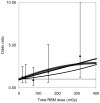Risk of hematological malignancies among Chernobyl liquidators
- PMID: 19138033
- PMCID: PMC2904977
- DOI: 10.1667/RR1231.1
Risk of hematological malignancies among Chernobyl liquidators
Abstract
A case-control study of hematological malignancies was conducted among Chernobyl liquidators (accident recovery workers) from Belarus, Russia and Baltic countries to assess the effect of low- to medium-dose protracted radiation exposures on the relative risk of these diseases. The study was nested within cohorts of liquidators who had worked around the Chernobyl plant in 1986-1987. A total of 117 cases [69 leukemia, 34 non-Hodgkin lymphoma (NHL) and 14 other malignancies of lymphoid and hematopoietic tissue] and 481 matched controls were included in the study. Individual dose to the bone marrow and uncertainties were estimated for each subject. The main analyses were restricted to 70 cases (40 leukemia, 20 NHL and 10 other) and their 287 matched controls with reliable information on work in the Chernobyl area. Most subjects received very low doses (median 13 mGy). For all diagnoses combined, a significantly elevated OR was seen at doses of 200 mGy and above. The excess relative risk (ERR) per 100 mGy was 0.60 [90% confidence interval (CI) -0.02, 2.35]. The corresponding estimate for leukemia excluding chronic lymphoid leukemia (CLL) was 0.50 (90% CI -0.38, 5.7). It is slightly higher than but statistically compatible with those estimated from A-bomb survivors and recent low-dose-rate studies. Although sensitivity analyses showed generally similar results, we cannot rule out the possibility that biases and uncertainties could have led to over- or underestimation of the risk in this study.
Figures


 Log-linear model – linear dose-response
Log-linear model – linear dose-response  Log-linear model – linear-quadratic dose-response
Log-linear model – linear-quadratic dose-response  ERR model – linear dose-response
ERR model – linear dose-response  ERR model – linear-quadratic dose-response
ERR model – linear-quadratic dose-response

References
-
- UNSCEAR. Sources and Effects of Ionizing Radiation - Volume II Effects. United Nations; New York: 2000.
-
- US NRC. Health Risks from exposures to low levels of ionizing radiation, BEIR VII. Washington, DC: National Research Council/National Academy of Sciences; 2006. Committee on the Biological Effects of Ionizing Radiation.
-
- ICRP (International Commission on Radiological Protection) Recommendations of the International Commission for Radiation Protection. Publication 103. Annals of the ICRP. 2007;37(2/3) - PubMed
-
- Cardis E, Vrijheid M, Blettner M, Gilbert E, Hakama M, Hill C, Howe G, Kaldor J, Muirhead CR, et al. The 15-country collaborative study of cancer risk among radiation workers in the nuclear industry: estimates of radiation related cancer risks. Radiat Res. 2007;167:396–416. - PubMed
Publication types
MeSH terms
Grants and funding
LinkOut - more resources
Full Text Sources
Medical

